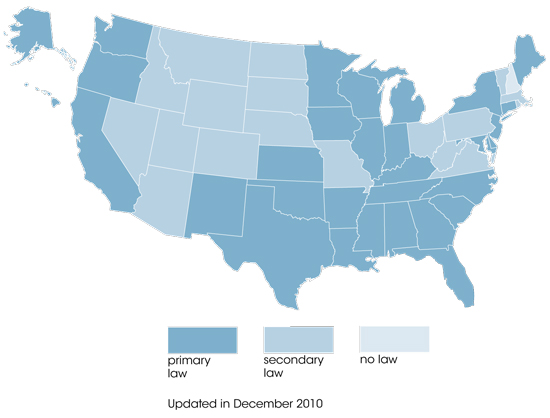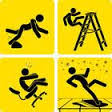Despite the majority of people knowing the national, “Click It Or Ticket” enforcement campaign, and the staggering statistics showing that wearing a seat belt is the most effective way to save lives (The Center for Disease Control and Prevention states that seat belts reduce the risk of death by 45%) and reduce injuries, millions of people still do not buckle-up.
According to the National Highway Traffic Safety Administration, thirteen percent of drivers still do not wear their seat belts.
Seat Belt Laws
The majority of seat belt laws in the United States are left to the states. However, the first seat belt law was a federal one. Title 49 of the United States Code, Chapter 301, requires all vehicles (except buses) to be fitted with seat belts in all designated seating positions. The law has now been modified to require three-point belts in all seating positions.
Although there is an over-arching federal law that involves seat belts, the states are free to create their own laws governing seat belt use. Laws requiring seat belt usage are either “primary” or “secondary” enforcement laws. Primary enforcement laws allow police officers to pull over drivers and issue a ticket just because the drivers, or their passengers, are not wearing their seat belts. However, secondary laws only allow police officers to issue tickets for seat belt violations once the driver has been pulled over for some other offense.
The age in which a driver or passenger is required to wear a seat belt varies from state to state. However, Arizona law requires that each front seat occupant must wear a lap and shoulder belt while the vehicle is in motions. A citation will be issued to the driver for each passenger under 16 years of age that is occupying the front seat and not wearing a seat belt. The exception to this rule is a child that is under five years old, which must be properly secured in a child restraint system.
Seat Belt Safety
The accurate way to wear a seat belt is to have the shoulder belt pulled over your shoulder (not under your arm or behind your back) and across your chest with the belt up close against the body.
Additionally, the lap belt should be close to the body and low on the hips. This positioning will allow the chest and the pelvis to take most of the force of a collision rather than other body parts, which may not be able to handle the impact.
Some of the common seat belt mistakes include:
• Not wearing a seat belt at all. Airbags are designed to work with seat belts, not to replace them. If you are not wearing your seat belt the impact could throw you forward while the airbag is being deployed and the impact may seriously injure or kill you.
• Wearing a seat belt that is too loose. If the seat belt is not close against your body, the impact of the accident could cause your body to slam against parts of the vehicle.
• Wearing the lap belt across your stomach instead of low on the hips. The stomach is not as equipped to sustain impact as the pelvis. If there is a collision, there is a good chance that there will be internal soft tissue injury if the seat belt is worn across the stomach. This is doubly important for pregnant women, who should not wear their seat belt across their stomach but should wear it lower toward their pelvis.
• Wearing the shoulder belt behind your back or under your arm. If there is an impact you are much more likely to slip through the seat belt and be thrown from the vehicle or slam into the inside of the vehicle.
• Making excuses to not wear a seat belt. Excuses such as: I’m not driving very far, the seat belt is uncomfortable to me or It’s not cool to wear a seat belt, may pose serious risks to the excuse maker and the other passengers in the vehicle. Studies show that 75 percent of accidents happen within 25 miles of the home. Furthermore, it is more important to be safe than a little uncomfortable and just because you are sitting in the back seat does not mean that you can’t be thrown through the windshield or hit other passengers.




